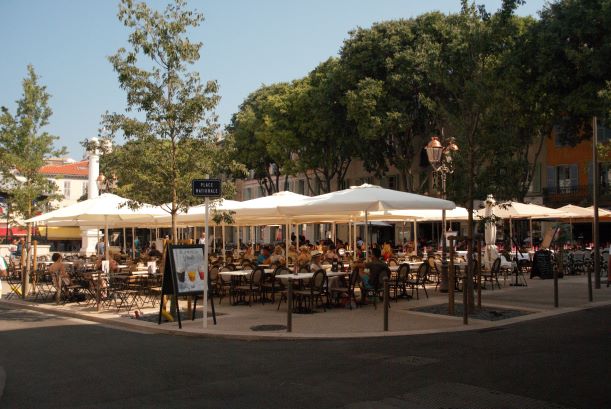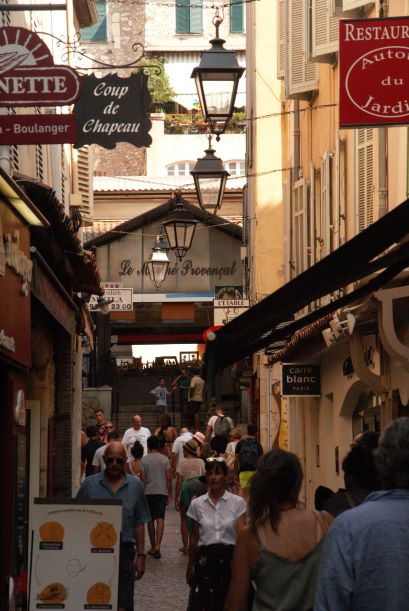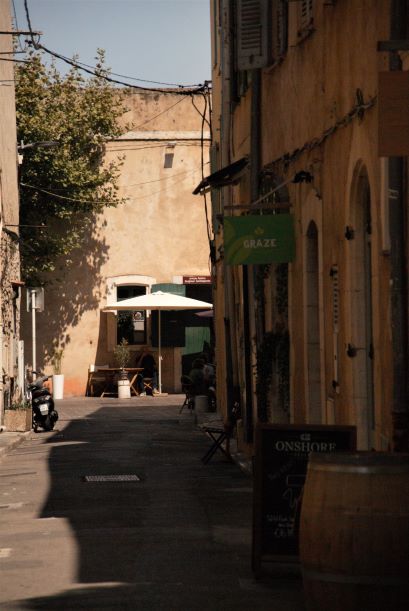Local Beaches
Antibes has three beaches: the Gravette; Ponteil; and Salis. The Gravette looks like an artifical harbour beneath the old town ramparts but can ony be used by swimmers. Although it has a sandy beach, the floor of the sea is rocky and some form of footwear is recommended. The Maxi Bazaar shop in the Place de la République usually has a stock of cheap ones. The other beaches are shallow and sandy.
Gravette
The water in the Gravette harbour is often clear as can be seen in this picture, but it can be cloudy after periods of strong wind, and also becomes less clear when very busy as the natural silt is stirred up. The water's cleanliness is evidenced by many small fish. There are two freshwater showers on the beach which is supervised by lifeguards during the summer season. A bar which serves food is located on the raised area behind the beach. There are lockers located next to the lifeguard's hut which take a 1 euro coin each time one is used.
The water deepens quickly as one swims towards the opening to the sea. The beach sand is sifted each morning in summer. Small jellyfish (medusa in French) tend to appear in late August/early September when the wind shifts to onshore. The lifeguards post a chalked up sign when this happens with the density of jellyfish indicated by showing one to three of them on the board.
Ponteil and Salis
As the picture shows, the two beaches are long, and sandy, and they gradually slope but can be a little seaweedy and are popular with families with small children and in the late afternoon with volley ball players. They are connected by a small promontory which has been recently redeveloped and includes the local sailing school and a handicap beach which has hard paths for wheel chairs, and young staff to help the disabled enjoy the sea. There is a business between the Ponteil beach and the town which will tow you out on various forms of rubber inflatable. One of its boats is speeding out from its quay in the picture, and where there is also a memorial to the covert landing of British submariners during the war to support the local Resistance. There is also the Royal Beach Club at this end where you can hire a recliner and umbrella: sunbathe without touching sand; get into the water without touching sand; and bar, restaurant, and toilet services are available.
Eglise Notre-Dame de la Garoupe and Light House
Antibes sits at the North East end of Cap d'Antibes, a promontory which contains the high class Hotel du Cap-Eden Roc, the Eilenroc Gardens and house, the landing place of Napoleon when he escaped Elba and began the march ultimately to Waterloo, the Garoupe beach area where Gerald and Sara Murphy and their Golden Era USA money created the taste for summer holidays enjoyed by F Scott Fitzgerald and the inter-war art colony. Previouly Juan les Pins and Antibes, sitting either side of top end of the Cap had been the playground of British and Russian aristocrats and old world USA millionaires, popular in winter because of their mild climate and that clean air which had drawn the artists of the 19C from Paris.
The church sits atop the Cap with the modern lighthouse over which you will probably pass if flying into Nice airport. It is from here that the picure on the Home page was taken. A pleasant walk on a hot day is up the Chemin de Calvaire which climbs from the Salis beach area through the shady trees many of which are olives and the food store of squirrels which can eat the raw, young, tart olives. In june local fishermen repeat a thousand plus year old tradition and carry a statue of the Virgin Mary from the old town, up the Chemin de Calvaire to the church. There is a cafe in the church buildings although opening times have been varied, and sometiems it has operated booze free. There are public toilets at the building which appear henerally open.
Shops and Restaurants
Opening hours: most shops in the old town and nearby open on Sundays but don't expect this for shops in the new town further inland. Shops deliberately appealing to tourists, such as restaurants, may still have a closing day each week. Many of the bars also serve food. Other shops, such as pharmacies and food retailers will close one day per week, if not two. This is nowadays largely down to France's Code de Travail which enforces the 35 hour week: it simply is not economic for small businesses to try and staff up for 7/7 opening. Also, many retailers will close between 13:00 and 16:00. The upside is they are open until 19:00 so you can get ingredients for the family's dinner after leaving the beach. Bars open early, 07:00 is not unknown, as cafes for breakfast. Bars and restaurants will stay open into the early hours of the morning in summer but cut back to about 20:00 to 22:00 outside of the high season.
Place Nationale and the Marchée have open air restaurants with a wide range of fare from Moules to Pizza.

The town has a wide range of food shops including several supermarkets the nearest of which is a Carrefour in the Place Nationale. As you would expect, there are several boulangeries and they also take it in turn to close. There are also boucheries and wet fish shops but the latter are expensive. If you have a car or fancy the bus, we would go up the large Carrefour hypermarket near the motorway junction for both fresh food and if stocking up on groceries for one or two weeks.




